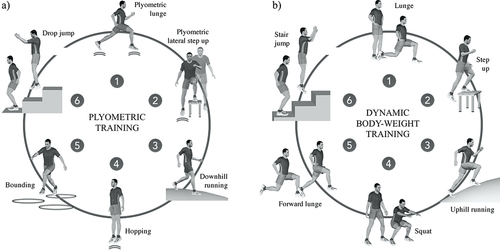Figures & data
Table 1. Characteristics of the 8-week running endurance training.
Figure 1. Circuit training protocol for the plyometric training (a) and dynamic body-weight training (b). Adapted from Patoz et al. (Citation2021) with permission.

Table 2. Characteristics of the 8-week strength training.
Table 3. Participant characteristics, initial peak treadmill speed, as well as pre-intervention running economy and running biomechanics (contact time, flight time, step frequency, duty factor, and leg stiffness) for participants following concurrent running endurance training with either plyometric (CSET-PLY) or dynamic body-weight training (CSET-DYN).
Figure 2. Pre- and post-intervention running economy (RE) for participants following concurrent running endurance training with either plyometric (CSET-PLY) or dynamic body-weight training (CSET-DYN). Two-way repeated measures ANOVA identified a significant pre-post effect (p ≤ 0.05).

Table 4. Pre- and post-intervention running biomechanics (contact time, flight time, step frequency, duty factor, and leg stiffness) as well as 95% confidence intervals [lower, upper], corresponding changes in running biomechanics (expressed in percent units), and Cohen’s d effect size for participants following concurrent running endurance training with either plyometric (CSET-PLY) or dynamic body-weight training (CSET-DYN).
Table 5. Pre- and post-intervention running economy (RE) and running biomechanics (contact time, flight time, step frequency, duty factor, and leg stiffness) as well as 95% confidence intervals [lower, upper], corresponding changes in RE and running biomechanics (expressed in percent units), and Cohen’s d effect size for high and low responders of concurrent running endurance training with either plyometric (CSET-PLY) or dynamic body-weight training (CSET-DYN).
Data availability statement
The dataset supporting this article is available on request to the corresponding author.
